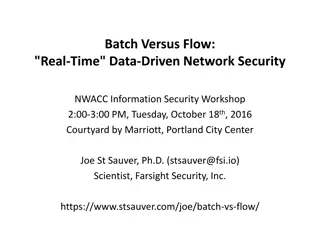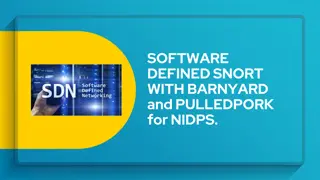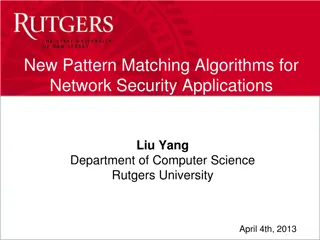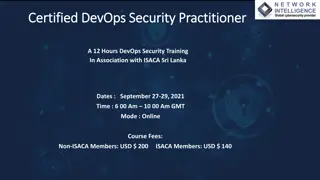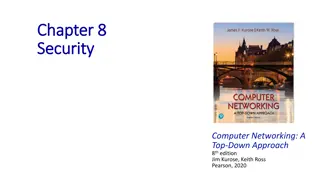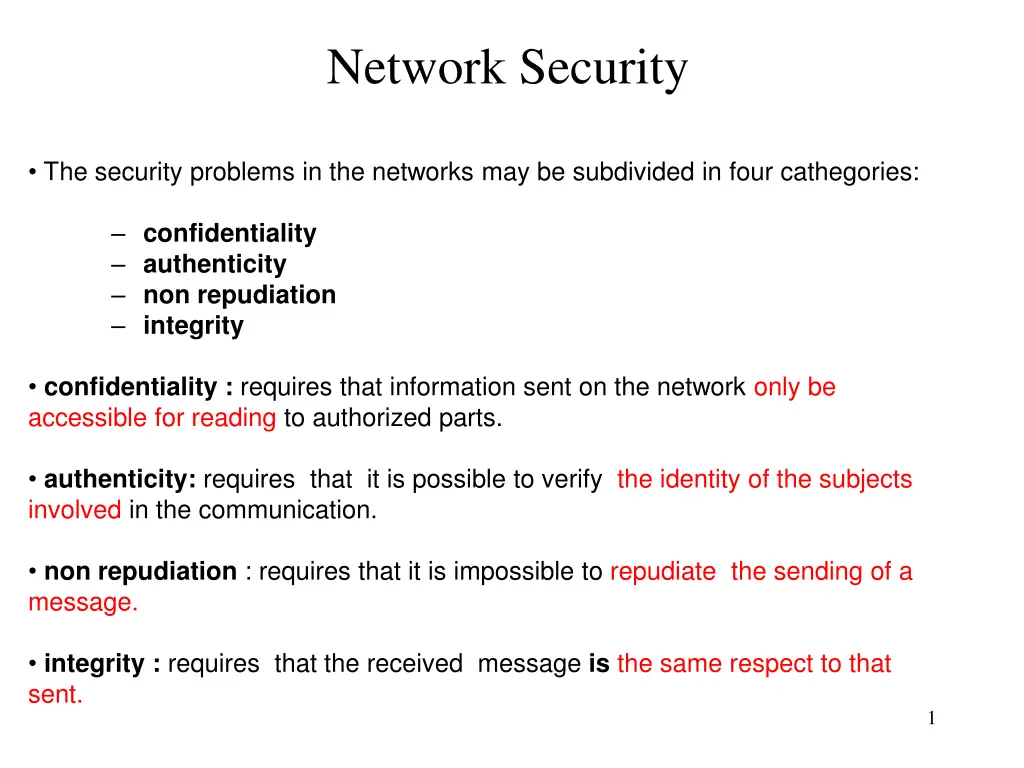
Understanding Network Security Threats
Explore the key categories of network security threats including confidentiality, authenticity, non-repudiation, and integrity. Learn about common threats like sniffing, address spoofing, and denial-of-service attacks, with examples to aid understanding.
Uploaded on | 0 Views
Download Presentation

Please find below an Image/Link to download the presentation.
The content on the website is provided AS IS for your information and personal use only. It may not be sold, licensed, or shared on other websites without obtaining consent from the author. If you encounter any issues during the download, it is possible that the publisher has removed the file from their server.
You are allowed to download the files provided on this website for personal or commercial use, subject to the condition that they are used lawfully. All files are the property of their respective owners.
The content on the website is provided AS IS for your information and personal use only. It may not be sold, licensed, or shared on other websites without obtaining consent from the author.
E N D
Presentation Transcript
Network Security The security problems in the networks may be subdivided in four cathegories: confidentiality authenticity non repudiation integrity confidentiality : requires that information sent on the network only be accessible for reading to authorized parts. authenticity: requires that it is possible to verify the identity of the subjects involved in the communication. non repudiation : requires that it is impossible to repudiate the sending of a message. integrity : requires that the received message is the same respect to that sent. 1
Types of threats a)Sniffing (snooping) A packet sniffer is a software that is able to capture each packet flowing in the network and, if needed, to decode and to analyze its content. Attack to the data confidentiality. 2
b)Address spoofing IP spoofing refers to the creation of IP packets with a forged source IP address, with the purpose of modifying the identity of the sender or impersonating another computing system. The machine that receives spoofed packets will send response back to the forged source address, which means that this technique is mainly used when the attacker does not care about the response. . 3
c) Denial of service A denial-of-service attack (DoS attack) or distributed denial-of-service attack (DDoS attack) is an attempt to make a computer resource unavailable to its intended users. It consists of the concerted efforts of a person or people to prevent an Internet site or service from functioning efficiently or at all, temporarily or indefinitely. Perpetrators of DoS attacks typically target sites or services hosted on high-profile web services such as bank credit cards payment gateways, and even root name servers. 4
Example: TCP SYN flood attack When a client attempts to start a TCP connection to a server, the client and server exchange a series of messages (TCP three way handsake) The client requests a connection by sending a SYN (synchronize) message to the server. The server acknowledges this request by sending SYN- ACK back to the client. The client responds with an ACK, and the connection is established. . 5
In case of attack a malicious client can skip sending the SYN ACK message. The server will wait for the acknowledgement for some time, as simple network congestion could also be the cause of the missing ACK. If these half open connections bind resources on the server, it may be possible to take up all these resources by flooding the server with SYN messages. Once all resources set aside for half- open connections are reserved, no new connections (legitimate or not) can be made, resulting in denial of service . 6
d)Trojan Horse A Trojan, sometimes referred to as a Trojan horse, is non- self-replicating program that appears to perform a desirable function for the user but instead facilitates unauthorized access to the user's computer system. Trojan horses are designed to allow a hacker remote access to a target computer system. Once a Trojan horse has been installed on a target computer system, it is possible for a hacker to access it remotely and perform various operations. Examples: attacks of spamming, DDoS, Data theft (e.g. passwords, credit card information, etc.),Installation of software (including other malware) ,Downloading-uploading of files ,modification or deletion of files, keystroke logging,.. 7
e) Backdoor A backdoor is a method of bypassing normal authentication, securing remote access to a computer, obtaining access to plaintext, and so on, while attempting to remain undetected. A backdoor can be designed during the development or maintenance phases of a program to allow the direct acces to the code or it may be derived by errors in designing or coding a program. 8
Attack to a DNS server Attack to the data integrity or to the service availability. Attack based on backdoor techniques: system control acquisition and modification of the data-base containing the corrispondence among logical and binary addresses DOS attack: the server is not accessible by the network nodes Sniffing or spoofing: the sending nodes will not receive an answer. 9
Cryptology. Cryptography: design and development of cryptographic systems. A plaintext is converted into apparently random non sense, referred to as ciphertext. Cryptanalysis: The process of attempting to decrypt the encrypted text. 10
Conventional Encryption Model The encryption process consists of an algorithm and a key. The key ia a value indipendent of the plaintext. The algorithm will produce a different output depending on the specific key being used at the time. Changing the key changes the output of the algorithm. The security of conventional encryption depends on the secrecy of the key, not the secrecy of the algorithm. The fact that the algorithm need not to be keptsecret means that manufactures can and have developed low- cost chip implementation of data encryption algorithms. 11
passive attacker active attacker attacker Encryption algorithm, E decryption algorithm, D plaintext,P cyphertext C = Ek(P) Encryption key,K Decryption key, K DK(EK(P))=P 12
E, D are mathematical functions named encryption algorithms and decryption algorithms. The algorithms, generally, are public and well known. The secret is the key. While the alghorithm always operare the same way, a different key used on the same plaintext will produces different ciphertext. A cryptographickey is a string used to characterize a known algorithm. . 13
It is foundamental that the algorithm is public. A cryptographyc system based on a secret algorithm presents serious drawbacks. In fact, it is necessary to change it everytime the danger exists that it is no more unknown. Instead, a key may be easily modified. . The basic model of a cryptographic system is constituted. of a solid, well known algorithm and a fixed size or variable size strong key . 14
Criptography Criptographic systems are generally classified along three independent dimensions: The type of operations used for transforming plaintext to ciphertext. All encryption algorithms are based on two general principles: substitution, in which each element in the plaintext (bit, letter, group of bit or letters) is mapped into another element, transposition, in which elements in the plaintext are rearranged Most systems, referred to as product systems, involve multiple stages of subsitution and transposition. 15
The criptographic methods are subdivided in two cathegories: - Transposition technique - Substitution technique In a transposition technique theunits of the plaintext ( (single letters, pairs of letters,..)are rearranged in a different and usually quite complex order, but the units themselves are left unchanged. In a substitution technique, the units of the plaintext are retainedin the same sequence in the cybertext, but the units themselves are altered. 16
The number of keys used If both sender and receiver use the same key, the system is referred to as symmetric, single key, secret key or conventional encryption. If the sender and the receiver each use a different key, the system is referred to as asymmetric, two key, or public key encription. The way in which the plaintext is processed. A block cypher processes the input one block of elements at a time, producing an output block for each input block. A stream cypher processes the input elements continously, producing output one element at a time, as it goes along. 17
Cryptanalysis brute force attack is a strategy used to break the encryption of data. It involves traversing the search space of all possible keys until the correct key is found. The resources required for a brute force attack scale exponentially with encreasing key size, not linearly. As a result doubling the key size for an algorithm does not simply double the required number of operations but rather squares them. Although there are algoritms which use 56-bit symmetric keys (e.g. Data Encryption Standard),usually 128-256 bit keys are standard. . If some words in the encrypted text are known, the decryption is simplified 18
Average time required for exhaustive key search keys size (bits) 32 56 128 168 number of altenative keys 232= 4.3 x 109 256=7.2 x 1016 2128=3.4x 1038 2168=3.7x 1050 time required at 106 decript/sec 2.15 msec 10 hours 5.4x1018 years 5.9x 1030 years 19
Computationally secure encryption scheme The cost of breaking the cipher exceeds the value of the encrypted information. The time required to break the cipher exceeds the useful lifetime of the information. 20
Substitution technique a) Caesar cipher each letter of the alphabet in the plaintext is replaced with the letter standing three places further down the alphabet. For instance, plaintext: encrypted text: de bello gallico gh ehoor ldoonfr A D, B E, C F Z C 21
Note that the alphabet is wrappep around, so that the letter following Z is A. We can define the trasformation by listing all possibilities, as follows: plain: a b c d e f g h i j k l m n o p q r s t u v w x y z D E F G H I J K L M N O P Q R S T U V W X Y Z A B C If we assign a numerical equivalent to each letter (a=1,b=2,..) for each plaintext letter p, substitute the letter C C=E(p)=(p+3)mod 26 22
A shift may be of any amount, so that the general Caesar algorithm is: C=E(p)=(p+k)mod(26) where k takes on a value in the range 1 to 25. The decryption algorithm is P=D(C)= (C-k) mod(26) There are only 25 possible keys 23
b) Monoalfabetic Ciphers Each character in the plaintextis replaced by an another character (arbitrary substitution). plaintext: : cipher line: Q W E R T Y U I O PR S T U V W X Y Z X C V B N M a b c d e f g h i j l m n o p q r s t u v w x y z The cipher line can be any permutation of the 26 alphabetic characters, then there are 26! (4x1026 ) possible keys. However, if the cryptanalyst knows the nature of the plaintext (e.g. non compressed english text) then the analist can exploit the regularities of the language (relative frequence of the letters,frequence of two letter combination,..) 24
- in english language e is the most common letter, followed by t,o,a,n,i,etc.. - Two letters (digrams) more common: th, in, er,re,an. - Three letters (trigrams) more common: the,ing, and,e ion The relative frequency of the letters of the encrypted text is evaluated; to the letter with higher frequency the e letter is associated, then the letter t etc.. If there are trigrams of the form tXe the letter X is substituted by h, ec.. 25
c) monouse blocks Key: random generated string of bit (monouse block) The plain text is converted in a string of bit using, ad example, the ASCII representation for the characthers. XOR of the two strings is evaluated (encrypted text ) The encrypted text cannot be decrypted independently by the computer power is used. The encrypted message does not contain any information because all possible plaintexts are contained in it with the same probability . A criptoanalyst could try all the possible combination of monouse blocks to verify the resulting plaintext 26
Example Message i love you is converted using a 7 bit ASCII code Message : 1001001 0100000 1101100 1101111 1110110 1100101 0100000 1111001 1101111 1110101 0101110 Monouse block 1: 1010010 1001011 1110010 1010101 1010010 1100011 0001011 0101010 1010111 1100110 0101011 Encrypted text 1 : 0011011 1101011 0011110 0111010 0100100 0000110 0101011 1010011 0111000 0010011 0000101 Monouse block 2 1011110 0000111 1101000 1010011 1010111 0100110 1000111 0111010 1001110 1110110 1110110 Encrypted text 2 1000101 1101100 1110110 1101001 1110011 0100000 1101100 1101001 1110110 1100101 1110011 Elvis lives 27
The encrypted message does not contain any information because it contains all the fixed length possible plaintext with the same priority. In the previous example the criptoanalyst could text all the possible combinations of monouse blocks in order to verify which plaintext may be obtained. In the previous example using the second monouse block the result could be Elvis lives . For each 11 ASCII plaintext characters we can find a generating monouse block. 28
Monouse blocks:problems To decrypt the message all the possible combinations of monouse blocks can be used in order to examine the corresponding plaintexts. It is possible to find more acceptable plaintexts. For each 11 characthers ASCII text it is possible to find a monouse block able to generate it. There is no information on the encrypted text Problems Sender and receiver must know a copy of the key (network transmission). The amount of sent data is limited by the key length. 29
Transposition Techniques Columnar transposition M E G A B U C K 7 4 5 1 2 8 3 6 p l e a s e t r a n s f e r o n e m i l l i o n d o l l a r s t O m y s w i s s . plaintext: encrypted text: key (no duplicated letters) numerical position in the alphabet pleasetransferonemilliondollarstomyswiss AFLLSKSOSELAWAIATOOSSCTCLNMOMANTESILYNT.. The encrypted text is read by columns beginning from the column with lowest key letter. Even in this case the statistical properties of the language may be used to facilitate the work of a cryptoanalyst. 30
Symmetric key algorithms secret key secret key plaintext plaintext algorithm algorithm encrypted encrypted text text Two types A block cypher processes the input one block of elements at a time, producing an output block for each input block. A stream cypher processes the input elements continously, producing output one element at a time, as it goes along. 31
DES (Data Encryption Standard) Adopted in 1977 by the National Bureau of Standards as Federal Information Processing Standard. The plaintext is encrypted in blocks of 64 bits The algorithm is parameterized with a 56 bits key and involves 19 rounds. The first round , independently by the key, provides to the transposition of the 64 bits of the plaintext. The last round is the contrary of the first round. In the second last the leftmost bits are exchanged with the rightmost bits The remaining 16 rounds are functionally the same, but parameterized with different keys 32
DES The algorithm allows the decrypting using he same key used for encrypting (simmetric algorithm) The stages are executed in the contrary order in the two cases. The operations in one of the 16 intermediate rounds are: - the 64 bits input are subdivided in two 32 input ( left and rigth.) and produces two 32 output ( left and rigth.) - the left output is a copy of the rigth input - the rigth output is obtained applyng bit by bit the XOR among the left input and a function of the rigth input and of the key relative to this round,Ki-1 33
Per round key generation The 48 bit key Ki for round i is derived from the 56-bit master key as follows: - The master key is permuted and divided into two 28 bit halves - For each round, each half is first rotated one or two bits to the left, after which 24 bits are extracted - Togheter with 24 bits from the other rotated half, a 48-bit is constructed 34
Realized by IBM in 1974. Agreement between IBM and U.S. NSA (National Security Agency). There is the suspect that the algorithm had been covertly weakened by the Intelligence Agency so that they, but no- one else, could easily read encrypted messages. Published as an Official Federal Information Processing Standard (FIPS) in 1977. 36
The strength of DES 1998. Electronic Frontier Foundation (EFF) announced that it had broken a new DES challenge using a special purpose DES cracker machine that was built for less than $ 250,000. The attack took 22 hours 15 minutes Hardware prices will continue to drop as speed increase, making DES worthless. Fortunately, there are a number of alternative available in the marketplace. 37
Triple DEA Given the potential vulnerability of DES to a brute force attack, there has been considerable interst in finding an alternative. One approach, which preserves the existing investment in software and equipment, is to use multiple encryption with DES and multiple keys. Triple DEA (TDEA) usese two keys and three executions of the DES algorithm 38
K1 K2 K1 K1 K2 K1 P E E D P C C E D D In the first stage, the plaintext is encrypted using DES with the K1 key. In the second stage DES is used in decrypting way using K2 key. In the third stage the resulting text is encrypted by using K1. Both K1 and K2 are 112 bits keys 39
AES (Advanced Encription Standard) NIST (National Institute of Standards and Technology) 1997: World-wide cryptografic competition.Rules: 1. Simmetric algorithm 2. Public algorithm 3. Key lenght:128,192,256 bit. 4. Hardware and software implementations Rijndael (Joan Daemen and Vincent Rijmen). Two solutions: 128 bit block, 128 bit key 128 bit block, 256 bit key 40
Symmetric encryption problems Key distribution Source authentication and non repudiation 41
Key distribution For symmetric encryption technique to work, the two parties to an exchange must share the same key, and that key must be protected from an access by others. Key distribution technique: -A key can be selected by A and phisically delivered to B - A third part can select the key and phisically deliver it to A and B - If A and B have previously and recently used a key, one party can transmit the new key to the other, encrypted using the old key 42
In a distributed system, any given host or terminal may need to engage in exchanges with many others hosts and terminals over time. Thus, each device needs a number of keys supplied dynamically. If encryption is done at the application level , then a key is necessary for every pair of users or processes that require communication. In a system with N users there are N(N-1)/2 pairs of users and then it is necessary to exchange N(N-1)/2 secret keys A network using node-level encryption with 1000 nodes would need to distribute as many as half a million keys. If the same network supported 10000 applications, then 50 milion keys may be required for application level encryption. 43
KDC (Key Distribution Center) KDC shares a secret key with every user and then it can comunicate in a secure way with each user. When Alice wants to communicate with Bob, she sends a request to the KDC. KDC asks Bob if he want to communicate with Alice and in the case of a positive answer, it will create a secret key (session key) and will communicate the key both toAlice and Bob. Bob and Alice will communicate by using the session key. Obviously, it necessary to distribute a secret key for each user. The problem has been reduced by N(N-1)/2 keys to N keys 44
Public key encryption The encryption technique assign each user a pair of keys. One of the user s keys, called the private key, is kept secret, while the other, called the public key, is published along the name of the user, so everyone knows the value of the key. Two properties The cryptographic algorithm has the mathematical property that a message encrypted with the public key can be decrypted only with the relative private key. It is computationally infeasible to determine the decryption key given only knowledge of the cryptographic algorithm and the encryption key. 45
RSA Rivest, Shamir, Adleman. MIT (1978) Clifford Christopher Cocks . In 1973, while working at the United KingdomGoverment communications Headquarters,(GCHQ), he invented a public key algorithm equivalent to RSA. The Cocks idea was classified information and his insight remained hidden for 24 years, despite being independently invented by Rivest, Shamir, Adleman . 46
Keys of 1024 to 4096 bit are required in order to obtain a good security. The algorithm is computationally complex . It is based on the properties of prime numbers. It is the only widely accepted and implemented general purpose approach to public key encryption. . 47
RSA pair of keys for each user (Kpub,Kpriv)A (Kpub,Kpriv)B Key properties: - A message encrypted with one of the two keys is decryptable only with the other - Known one the two keys (public), is impossible obtain the other (private) to 48
Performance: RSA in hardware: is about 1000 times slower than DES RSA in software: is about 100 times slower than DES 49
Confidentiality(encryption) The essential steps for sending an encrypted message : Each user generates a pair of keys to be used for the encryption and decryption of messages. Each user places one of the two keys in a public register or other accessible file (public key). The other key is private. If Bob wishes to send a private message to Alice, Bob encrypts the message using Alice s public key. When Alice receives the message, she decrypts it using her private key. No other recipient can decrypt the message because only Alice knows Alice s private key. 50









